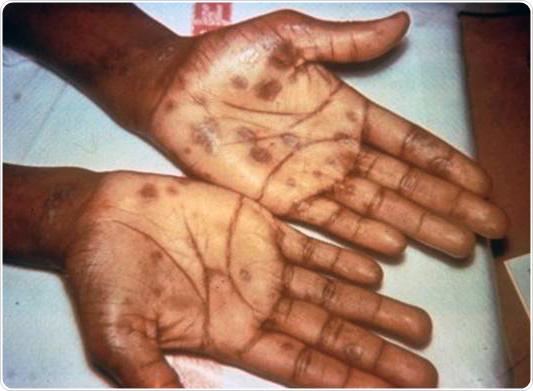Syphilis is essentially a bacterial infection. It is a sexually transmitted infection that spreads via unprotected sex with an infected person.

Secondary stage syphilis sores (lesions) on the palms of the hands. Referred to as "palmar lesions."
Cause and transmission of syphilis
Syphilis is caused by bacteria called Treponema pallidum. These can enter via an infected sore normally during vaginal, anal or oral sex or by sharing sex toys with someone who is infected.
In addition, pregnant mothers who are infected can pass the condition on to their unborn baby. This can cause congenital abnormalities in the baby or even still birth and death immediately after birth.
Syphilis may also be caught by sharing needles with an infected person or receiving infected blood transfusion. This last mode of transmission is extremely rare as all blood transfusions are tested for syphilis.
Syphilis does not spread by sharing a toilet, clothing, cutlery or bathroom with an infected person as the bacteria cannot survive for long outside the human body.
Syphilis symptoms
The disease has three distinct stages. Symptoms vary according to the stage of the disease.
Stage 1
This is termed as primary syphilis. This begins as a painless but highly infectious sore on the genitals or sometimes around the mouth. The sore lasts two to six weeks before disappearing.
Stage 2
This is termed secondary syphilis. There are other symptoms such as skin rash and sore throat. These also disappear within a few weeks. The infection then goes into a latent phase or hidden phase with no symptoms, which can last for years. After this, syphilis can progress to its third stage. In the latent phase the disease cannot be spread unlike in stages 1 and 2 when the person is infectious.
Stage 3
This is also called tertiary syphilis. This is the most dangerous phase. Around a third of people who are not treated for syphilis will develop tertiary syphilis. This may damage the brain, eyes and the body severely.
Incidence and prevalence of syphilis
Once a dreaded disease, the advent of antibiotics had reduced the general prevalence of the disease. However, over the past decade incidence of this infection is on the rise. Despite this, syphilis is still one of the less common sexually transmitted infections in the UK.
There have been several local outbreaks across England, the largest of which was in London between 2001 and 2004. High risk group includes men who have sex with men (over 70% cases). The highest rates of syphilis are seen in women aged 20-24 and men aged 25-34 years. There is a strong relationship with co-infection with HIV. Due to high rates of infection among women there is an increase in congenital syphilis as well.
In 2003, there were 1,580 cases diagnosed in sexually transmitted disease (STD) clinics in England, Wales and Northern Ireland. There were 3,762 diagnoses of infectious syphilis in 2007. Between 2009 and 2010, there were 2,624 cases of syphilis diagnosed in the UK. The tertiary stage is now rarely seen in the UK, possibly because those affected many years ago have received antibiotics.
Diagnosis of syphilis
Those with syphilis or with high risk sexual behavior may get themselves tested at the genitourinary medicine (GUM) clinic, sexual health clinic or their general practitioners. The earlier syphilis is treated, the less chance there is of serious complications.
Syphilis treatment
If diagnosed early, treatment and cure is easily achieved with antibiotics, usually penicillin injections. However, if it is not treated, syphilis can progress to a more dangerous form of the disease.
In addition, those with syphilis are three to five times more likely to catch HIV infection as well. This is because the genital sores caused by syphilis can bleed easily allowing entry of HIV in blood during sexual activity.
The only guaranteed way to prevent a syphilis infection is to avoid unprotected sex and adopt safe sex measures.
Further Reading
Last Updated: Jun 21, 2023